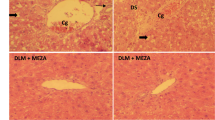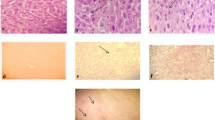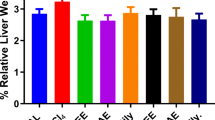Abstract
Jasminum humile (Linn) is highly valued for its medicinal properties. The pulp and decoction made from its leaves are effective for skin diseases. Juice prepared from roots is used against ringworm illness. Our current study aims to illustrate the non-toxicity and protective potential of methanol extract of Jasminum humile (JHM) against CCl4-induced oxidative stress in the liver of rats. Qualitative phytochemical screening, total flavonoids (TFC), and total phenolic content (TPC) assays were performed with JHM. The toxicity of the plant was estimated by treating female rats at different JHM doses while to assess anti-inflammatory potential of plant nine groups of male rats (six rats/group) received different treatments such as: CCl4 only (1 ml/kg mixed with olive oil in a ratio of 3:7), silymarin (200 mg/kg) + CCl4, different doses of JHM alone at a ratio of 1:2:4, and JHM (at a ratio of 1:2:4) + CCl4, and were examined for different antioxidant enzymes, serum markers, and histological changes, while mRNA expression of stress, inflammatory and fibrosis markers were assessed by real-time polymerase chain reaction analysis. Different phytochemicals were found in JHM. A high amount of total phenolic and flavonoid content was found (89.71 ± 2.79 mg RE/g and 124.77 ± 2.41 mg GAE/g) in the methanolic extract of the plant. Non-toxicity of JHM was revealed even at higher doses of JHM. Normal levels of serum markers in blood serum and antioxidant enzymes in tissue homogenates were found after co-administration of JHM along with CCl4. However, CCl4 treatment caused oxidative stress in the liver by enhancing the levels of stress and inflammatory markers and reducing antioxidant enzyme levels, while JHM treatment showed significant (P < 0.05) downregulation was in mRNA expression of those markers. Investigation of mechanism of specific signaling pathways related to apoptosis and clinical trials to assess safety and efficacy of optimal dosage of Jasminum humile will be helpful to develop FDA-approved drug.




Similar content being viewed by others
Data availability
The data are contained within the article.
References
Aebi H (1984) Catalase in Vitro. Method Enzymol 105:121–126
Akcora BÖ, Storm G, Bansal R (2018) Inhibition of canonical WNT signaling pathway by β-catenin/CBP inhibitor ICG-001 ameliorates liver fibrosis in vivo through suppression of stromal CXCL12. Biochem Biophys Acta 1864:804–818
Ali S, Khan MR, Sajid M (2017) Protective potential of Parrotiopsis jacquemontiana (Decne) Rehder on carbon tettetrachloride-inducedpatotoxicity in experimental rats. Biomed Pharmacot 95:1853–1867
Al-Olayan E, El-Khadragy M, Aref A, Othman M, Kassab R, Abdel Moneim A (2014) The potential protective effect of Physalis peruviana L against carbon tetrachloride-induced hepatotoxicity in rats is mediated by suppression of oxidative stress and downregulation of MMP-9 expression. Oxidat Med Cell Long. 11:332
Al-Rasheed NM, Attia HA, Mohamad RA, Al-Rasheed NM, Al-Amin MA, Al-Onazi A (2015) Aqueous date flesh or pits extract attenuates liver fibrosis via suppression of hepatic stellate cell activation and reduction of inflammatory cytokines, transforming growth factor- β 1 and angiogenic markers in carbon tetrachloride-intoxicated rats. Evid-Based Compl Alternat Med. 94:1256
Apostolou A, Stagos D, Galitsiou E, Spyrou A, Haroutounian S, Portesis N, Trizoglou I, Wallace Hayes A, Tsatsakis AM, Kouretas D (2013) Assessment of polyphenolic content, antioxidant activity, protection against ROS-induced DNA damage and anticancer activity of Vitis vinifera stem extracts. Food Chem Toxicol 61:60–68
Araujo Leon JA, Ruiz Ciau DV, Coral Martinez TI, Cantillo Ciau ZO (2015) Comparative fingerprint analyses of extracts from the root bark of wild Hippocratea excelsa and “cancerina” by high-performance liquid chromatography. J Sep Sci 38:3870–3875
Batool R, Rashid Khan M, Ahmed Zai J, Ali S, Maryam S, Naz I, Bibi S (2018) Brachychiton populneus (Schott & Endl.) R.Br. ameliorate carbon tetrachloride induced oxidative stress through regulation of endoplasmic reticulum stress markers and inflammatory mediators in Sprague-Dawley male rats. Biomed Pharmacother 107:1601–1610
Batool R, Khan MR, Sajid M, Ali S, Zahra Z (2019) Estimation of phytochemical constituents and in vitro antioxidant potencies of Brachychiton populneus (Schott & Endl.) R. Br BMC Chemistry 1:1–5
Ben Hsouna A, Hfaiedh M, Ben Slima S, Romdhane WB, Akacha BB, Bouterra MT, Dhifi W, Mnif W, Brini F, Ben Saad R, Ben Salah R (2022) Antioxidant and hepatoprotective effects of novel heteropolysaccharide isolated from Lobularia maritima on CCl4-induced liver injury in rats. Food Sci Nutrit. 10:2284
Bourebaba N, Marycz K (2021) Hepatic stellate cells role in the course of metabolic disorders development–A molecular overview. Pharmacol Res 170:105739
Breikaa RM, Algandaby MM, El-Demerdash E, Abdel-Naim AB (2013) Multimechanistic antifibrotic effect of biochanin a in rats: implications of proinflammatory and profibrogenic mediators. PLoS ONE 7:e69276
Chauhan NS (1999) Medicinal and aromatic plants of Himachal Pradesh. Indus publishing, USA
Chen Q, Zhan Q, Li Y, Sun S, Zhao L, Zhang H, Zhang G (2017) Schisandra Lignan Extract Protects against Carbon Tetrachloride-Induced Liver Injury in Mice by Inhibiting Oxidative Stress and Regulating the NF- B and JNK Signaling Pathways. Evid-Based Compl Alternat Med. 22:443
Cheng Y (2010) Survival and death of endoplasmic-reticulum-stressed cells: Role of autophagy. World J Biol Chem 2:226
Chomczynski P, Sacchi N (2006) The single-step method of RNA isolation by acid guanidinium thiocyanate-phenol-chloroform extraction: Twenty-something years on. Nature Protocol 1:581–585
Cullinan SB, Zhang D, Hannink M, Arvisais E, Kaufman RJ, Diehl JA (2003) Nrf2 Is a Direct PERK Substrate and Effector of PERK-Dependent Cell Survival. Mol Cell Biol 23:7198–7209
Dhiman AK (2004) Medicinal plants of Uttaranchal state. Chowkhamba Sanskrit Series off. 2:332
Dzoyem JP, Eloff JN (2015) Anti-inflammatory, anticholinesterase and antioxidant activity of leaf extracts of twelve plants used traditionally to alleviate pain and inflammation in South Africa. J Ethnopharmacol 160:194–201
El-Kashef DH, Zaghloul RA (2022) Ameliorative effect of montelukast against carbon tetrachloride-induced hepatotoxicity: Targeting NLRP3 inflammasome pathway. Life Sci 204:120707
Fu Y, Zheng S, Lin J, Ryerse J, Chen A (2008) Curcumin protects the rat liver from CCl4-caused injury and fibrogenesis by attenuating oxidative stress and suppressing inflammation. Mol Pharmacol 73:399–409
Gandhare B, Soni N, Dhongade HJ (2010) In vitro antioxidant activity of Bombax ceiba. Int J Biomed Res 2:31–36
Grisham M, Johnson G, Lancaster J (1996) Quantitation of nitrate and nitrite in extracellular fluids. Methods Enzymology 268:237–246
Hirschfield GM, Dyson JK, Alexander GJM, Chapman MH, Collier J, Hübscher S, Patanwala I, Pereira SP, Thain C, Thorburn D, Tiniakos D, Walmsley M, Webster G, Jones DEJ (2018) The British Society of Gastroenterology/UK-PBC primary biliary cholangitis treatment and management guidelines. Gut 9:1568–1594
Huang H, Lei H, Yang F, Fan X, Dang Q, Li Y (2018) Activation of the bile acid receptor GPBAR1 (TGR5) ameliorates interleukin-1β (IL-1β)-induced chondrocytes senescence. Biomed Pharmacother 106:1713–1719
Iqbal M, Wright D (1996) Host resistance to insecticides can confer protection to endolarval parasitoids. Bull Entomology Research 86:721–723
Jiang Y, Wang C, Li YY, Wang XC, An JD, Wang YJ, Wang XJ (2014) Mistletoe alkaloid fractions alleviates carbon tetrachloride-induced liver fibrosis through inhibition of hepatic stellate cell activation via TGF-β/Smad interference. J Ethnopharmacol 158:230–238
Kakkar P, Das B, Viswanathan PN (1984) A modified spectrophotometric assay of superoxide dismutase
Kala CP (2005) Ethnomedicinal botany of the Apatani in the Eastern Himalayan region of India. J Ethnobiol Ethnomed 1:1–8
Khan A, Farooq U, Ullah F, Iqbal J, Khan AF, Zaib S, Khan AR, Azarpira A (2014) Determination of biological activities and total phenolic contents of flowers of Jasminum humile and roots of Dorema aucheri. J Chem Soc Pak 2:291–295
Khedr NF, Khedr EG (2014) Antioxidant and Anti-inflammatory effects of curcumin on CCl4-induced liver fibrosis in rats. Am J Biomed Sci 3:191–200
Kim DO, Jeong SW, Lee CY (2003) Antioxidant capacity of phenolic phytochemicals from various cultivars of plums. Food Chem 81:321–326
Labonte AC, Tosello-Trampont AC, Hahn YS (2014) The role of macrophage polarization in infectious and inflammatory diseases. Mol Cells 4:275
Lee D, Park J, Kim M, Lee Y, Seo J, Ha N, Kim K (2015) Hepatoprotective effect of Bifidobacterium adolescentis SPM0212 on carbon tetrachloride induced hepatotoxicity. Korean Journal of Microbiology 51:280–287
Liu J, Gao S, Luo G, Yan G, Shen J (1988) Artificial Imitation of Glutathione Peroxidase with 6-Selenium-Bridged β Cyclodextrin. Biochem Biophys Res Commun 257:397–400
Lowry O, Rosebrough N, Farr A, Randall R (1951) Protein measurement with the Folin phenol reagent. J Boil Chem 193:265–275
Majid M, Khan MR, Shah NA, Haq IU, Farooq MA, Ullah S, Sharif A, Zahra Z, Younis T, Sajid M (2015) Studies on phytochemical, antioxidant, anti-inflammatory and analgesic activities of Euphorbia dracunculoides. BMC Complementary and Alternative Medicines 1:1–15
Malik K, Ahmad M, Öztürk M, Altay V, Zafar M, Sultana S (2021) Herbals of Asia: prevalent diseases and their treatments. Springer
Mansour KA, Elbermawi A, Al-Karmalawy AA, Lahloub MF, El-Neketi M (2022) Cytotoxic effects of extracts obtained from plants of the Oleaceae family: bio-guided isolation and molecular docking of new secoiridoids from Jasminum humile. Pharm Biol 60:1374–1383
Mukhtar S, Xiaoxiong Z, Qamer S, Saad M, Mubarik MS, Mahmoud AH, Mohammed OB (2021) Hepatoprotective activity of silymarin encapsulation against hepatic damage in albino rats. Saudi J Biol Sci 28:717–723
Naidu JR, Ismail R, Sasidharan S (2014) Acute oral toxicity and brine shrimp lethality of methanol extract of Mentha Spicata L (Lamiaceae). Trop J Pharm Res 13(1):101–107
Naz I, Khan MR, Zai JA, Batool R, Zahra Z, Tahir A (2020) Pilea umbrosa ameliorate CCl4 induced hepatic injuries by regulating endoplasmic reticulum stress, pro-inflammatory and fibrosis genes in rat. Environ Health Prev Med 1:1–5
Nowak JZ (2013) Oxidative stress, polyunsaturated fatty acids-derived oxidation products and bisretinoids as potential inducers of CNS diseases: focus on age-related macular degeneration. Pharmacol Rep 65:288–304
Park YS, Jung ST, Kang SG, Heo BG, Arancibia-Avila P, Toledo F, Drzewiecki J, Namiesnik J, Gorinstein S (2008) Antioxidants and proteins in ethylene-treated kiwifruits. Food Chem 107:640–648
Pawar H, Karde K, Mundle N (2014) Phytochemical evaluation and curcumin content determination of turmeric rhizomes collected from bhandara district of maharashtra (india). Med Chem 8:588–591
Pick E, Keisari Y (1981) Superoxide anion and hydrogen peroxide production by chemically elicited peritoneal macrophages—induction by multiple nonphagocytic stimuli. Cell Immunol 59:301–318
Ron D, Walter P (2007) Signal integration in the endoplasmic reticulum unfolded protein response. Nature Reviews Mol Cell Bio 8:519
Rutkowski DT, Wu J, Back SH, Callaghan MU, Ferris SP, Iqbal J, Clark R, Miao H, Hassler JR, Fornek J, Katze MG, Hussain MM, Song B, Swathirajan J, Wang J, Yau GDY, Kaufman RJ (2008) UPR Pathways Combine to Prevent Hepatic Steatosis Caused by ER Stress-Mediated Suppression of Transcriptional Master Regulators. Develop Cell 15:829–840
Sang MS, Il JC, Sang GK (2009) Resveratrol protects mitochondria against oxidative stress through AMP-activated protein kinase-mediated glycogen synthase kinase-3β inhibition downstream of poly(ADP-ribose) polymerase-LKB1 pathway. Molecular Pharma 76:884–895
Sarkhail P, Rahmanipour S, Fadyevatan S, Mohammadirad A, Dehghan G, Amin G, Shafiee A, Abdollahi M (2007) Antidiabetic effect of Phlomis anisodonta: Effects on hepatic cells lipid peroxidation and antioxidant enzymes in experimental diabetes. Pharmacol Res 56:261–266
Shukla S, Mehta A, Mehta P, Bajpai VK (2012) Antioxidant ability and total phenolic content of aqueous leaf extract of Stevia rebaudiana Bert. Experimental and Toxicologic Patho 64:807–811
Singh B, Singh S, Kishor A, Singh B (2021) Traditional usage of medicinal plants in humans and animals health care and their chemical constituents from hills and valleys of Jammu province, Western Himalaya. Indian J Nat Prod Resour 12:84–100
Sutti S, Bruzzì S, Albano E (2016) The role of immune mechanisms in alcoholic and nonalcoholic steatohepatitis: A 2015 update. Expert Rev Gastroenterol Hepatol 2:243–253
Taheri Y, Suleria HAR, Martins N, Sytar O, Beyatli A, Yeskaliyeva B, Seitimova G, Salehi B, Semwal P, Painuli S, Kumar A, Azzini E, Martorell M, Setzer WN, Maroyi A, Sharifi-Rad J (2020) Myricetin bioactive effects: Moving from preclinical evidence to potential clinical applications. BMC Compl Med Therap 1:1–14
Tan TC, Cheng LH, Bhat R, Rusul G, Easa AM (2014) Composition, physicochemical properties and thermal inactivation kinetics of polyphenol oxidase and peroxidase from coconut (Cocos nucifera) water obtained from immature, mature and overly-mature coconut. Food Chem 142:121–128
Valko M, Jomova K, Rhodes CJ, Kuča K, Musílek K (2016) Redox-and non-redox-metal-induced formation of free radicals and their role in human disease. Arch Toxicol 90:1–37
Vinothiya K, Ashokkumar N (2017) Modulatory effect of vanillic acid on antioxidant status in high fat diet-induced changes in diabetic hypertensive rats. Biomed Pharma 87:640–652
Xiao J, Ho CT, Liong EC, Nanji AA, Leung TM, Lau TYH, Fung ML, Tipoe GL (2014) Epigallocatechin gallate attenuates fibrosis, oxidative stress, and inflammation in non-alcoholic fatty liver disease rat model through TGF/SMAD, PI3 K/Akt/FoxO1, and NF-kappa B pathways. Euro J Nutrit 53:187–199
Yachi R, Igarashi O, Kiyose C (2010) Protective effects of vitamin E analogs against carbon tetrachloride- induced fatty liver in rats. J of Clinical Biochem Nutrit 47:148–154
Yadav RN, Agarwala M (2011) Phytochemical analysis of some medicinal plants. J Phytol 12:10–14
Yang J, Guo J, Yuan J (2008) In vitro antioxidant properties of rutin. LWT Food Sci Tech 41:1060–1066
Zai JA, Khan MR, Mughal ZUN, Batool R, Naz I, Maryam S, Zahra Z (2019) Methanol extract of: Iphiona aucheri ameliorates CCl4 induced hepatic injuries by regulation of genes in rats. Toxicol Res 8:815–832
Funding
This research received no external funding.
Author information
Authors and Affiliations
Contributions
Conceptualization, MF and MRK; methodology, MF; validation, MRK; formal analysis, MF; investigation, MF; resources, MRK; data curation, MF, and MRK; writing–original draft preparation, MF; writing–review and editing, MRK; supervision, MRK; all the authors have read and agreed to the published version of the manuscript.
Corresponding author
Ethics declarations
Conflict of interest
The authors declare no conflict of interest.
Informed consent
Not applicable.
Institutional review board statement
Standard principles for the handling of rats as issued by US guidelines (NIH publication #85–23, revised in 1985) were followed for the successful conduction of experiments after approval from board members of the Ethics Committee (Protocol code: 385) at Quaid-i-Azam University, Islamabad, Pakistan.
Additional information
Publisher's Note
Springer Nature remains neutral with regard to jurisdictional claims in published maps and institutional affiliations.
Rights and permissions
Springer Nature or its licensor (e.g. a society or other partner) holds exclusive rights to this article under a publishing agreement with the author(s) or other rightsholder(s); author self-archiving of the accepted manuscript version of this article is solely governed by the terms of such publishing agreement and applicable law.
About this article
Cite this article
Fatima, M., Khan, M.R. Jasminum humile (Linn) ameliorates CCl4-induced oxidative stress by regulating ER stress, inflammatory, and fibrosis markers in rats. Inflammopharmacol 31, 1405–1421 (2023). https://doi.org/10.1007/s10787-023-01230-z
Received:
Accepted:
Published:
Issue Date:
DOI: https://doi.org/10.1007/s10787-023-01230-z




